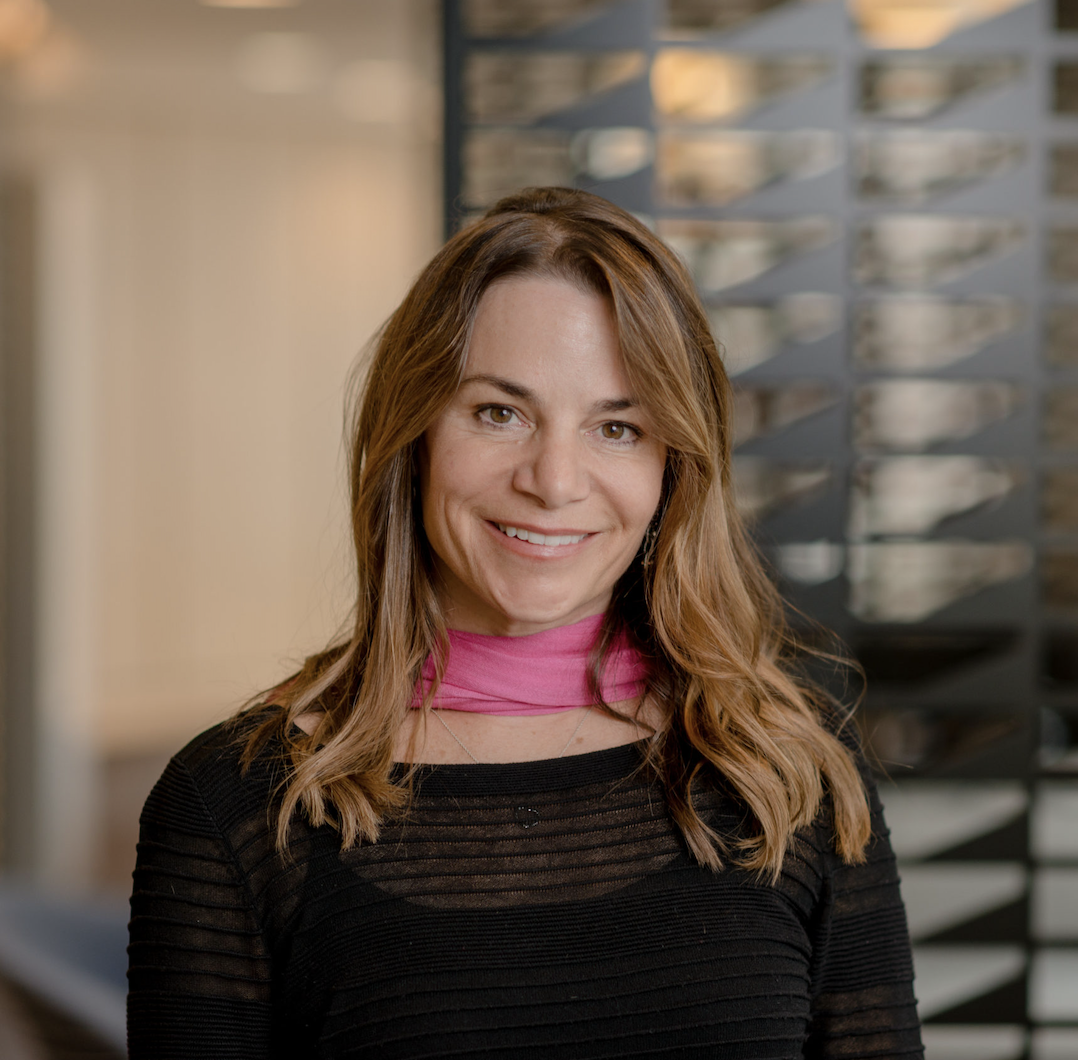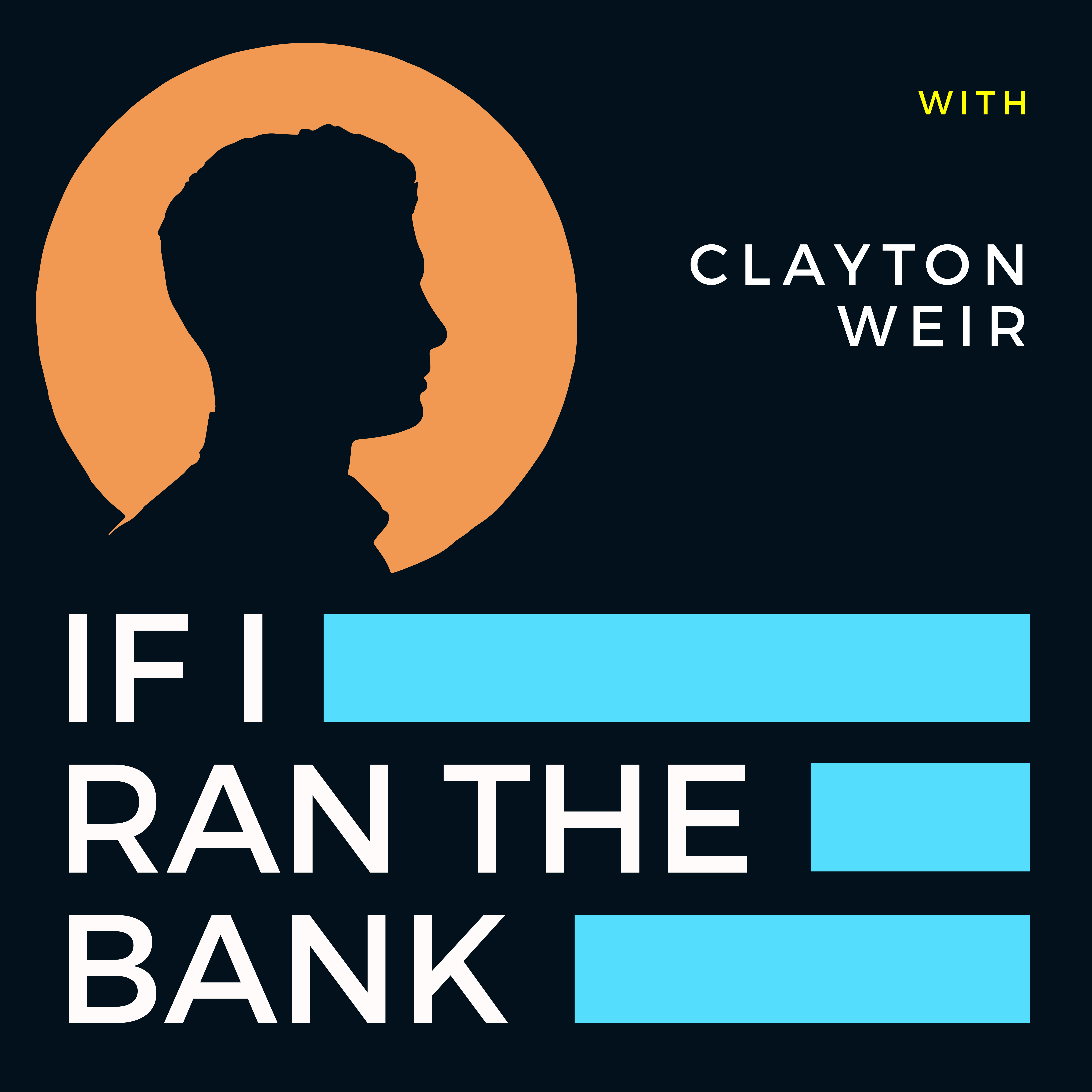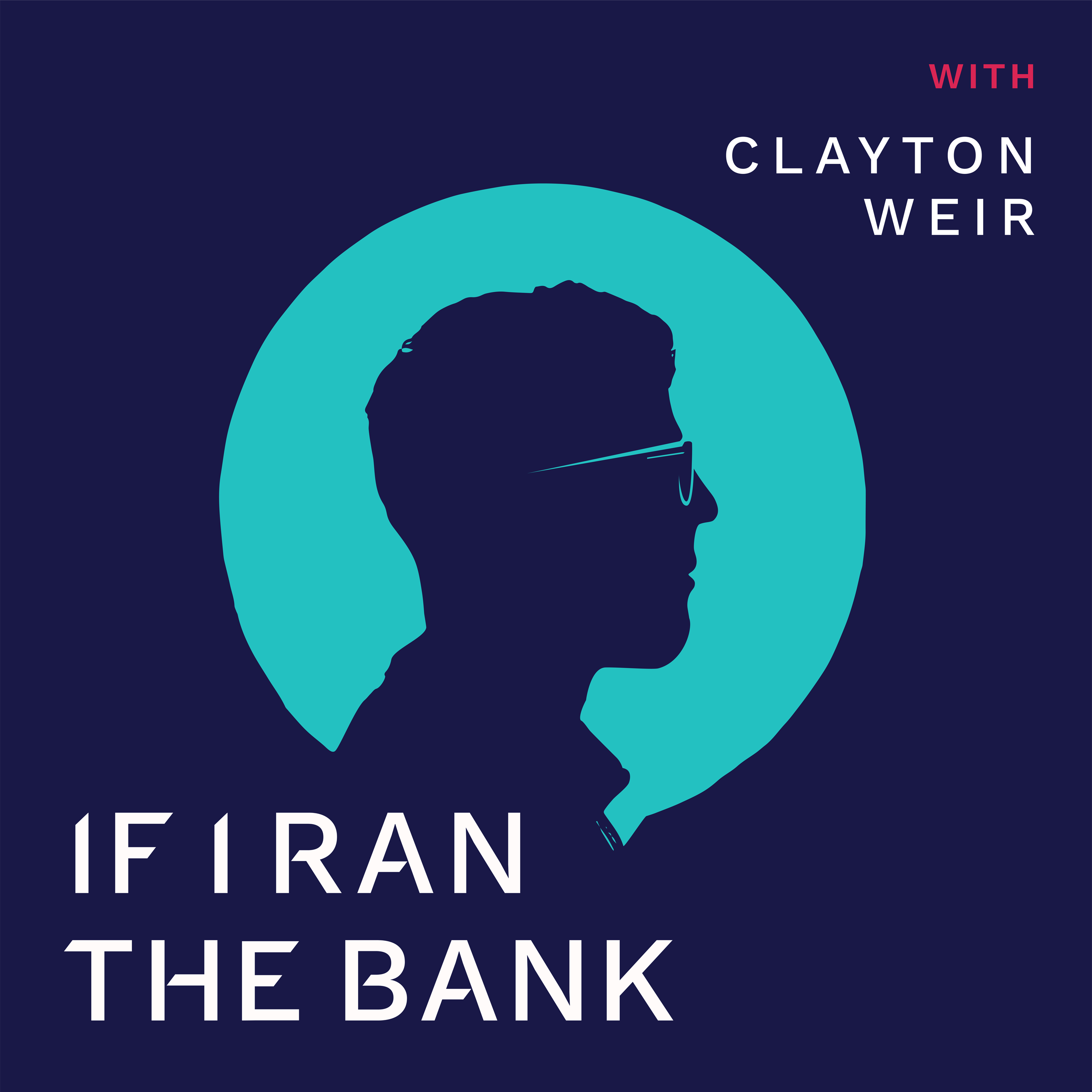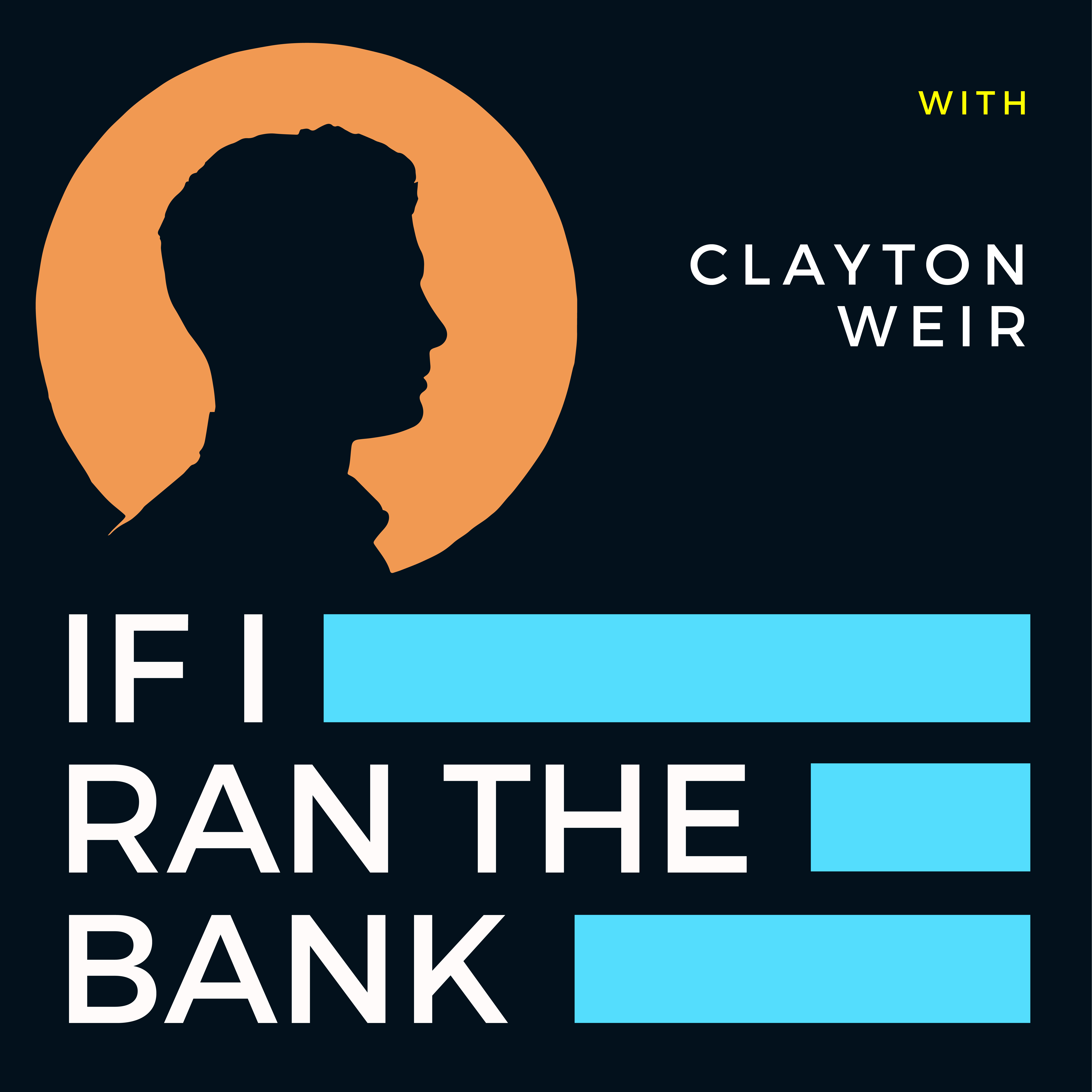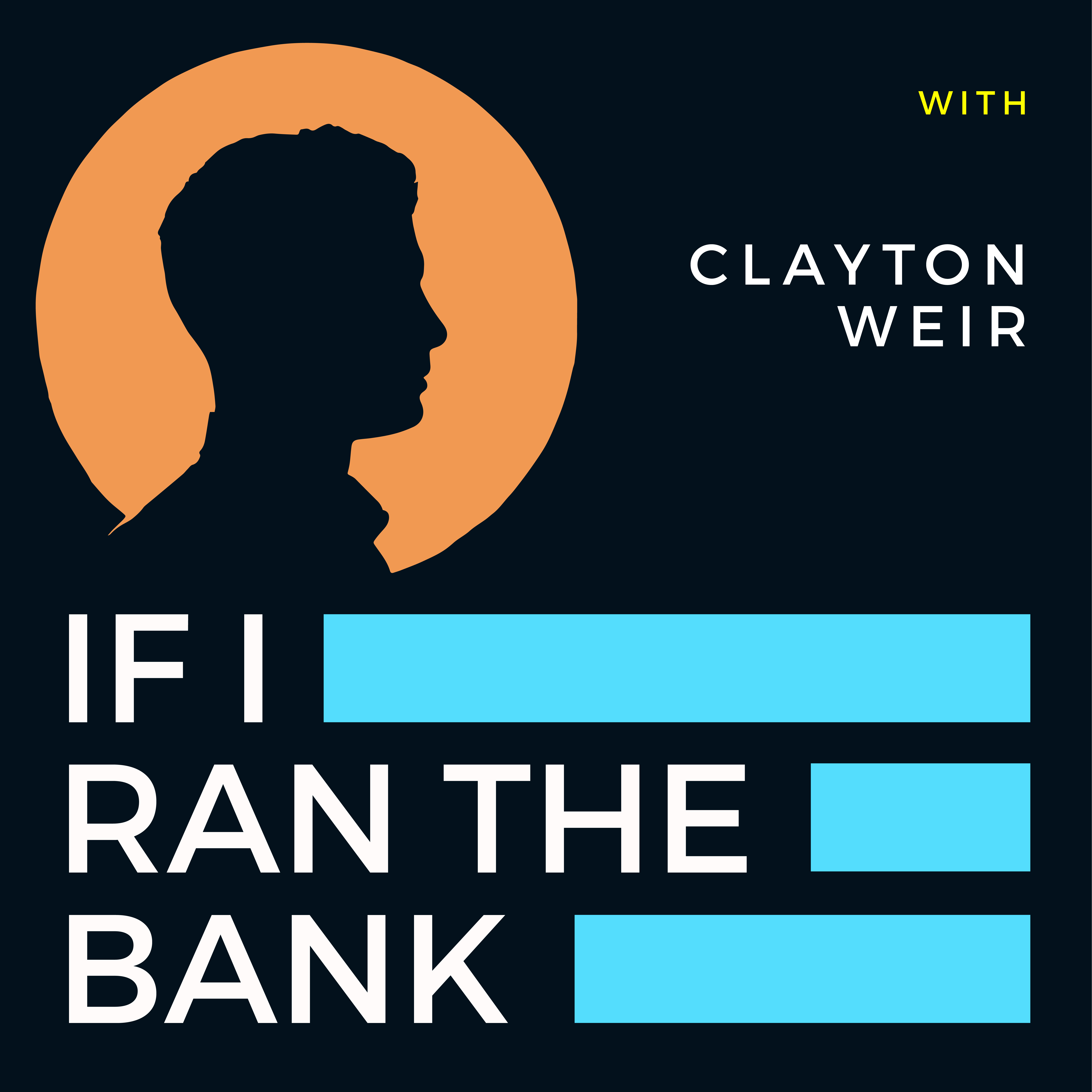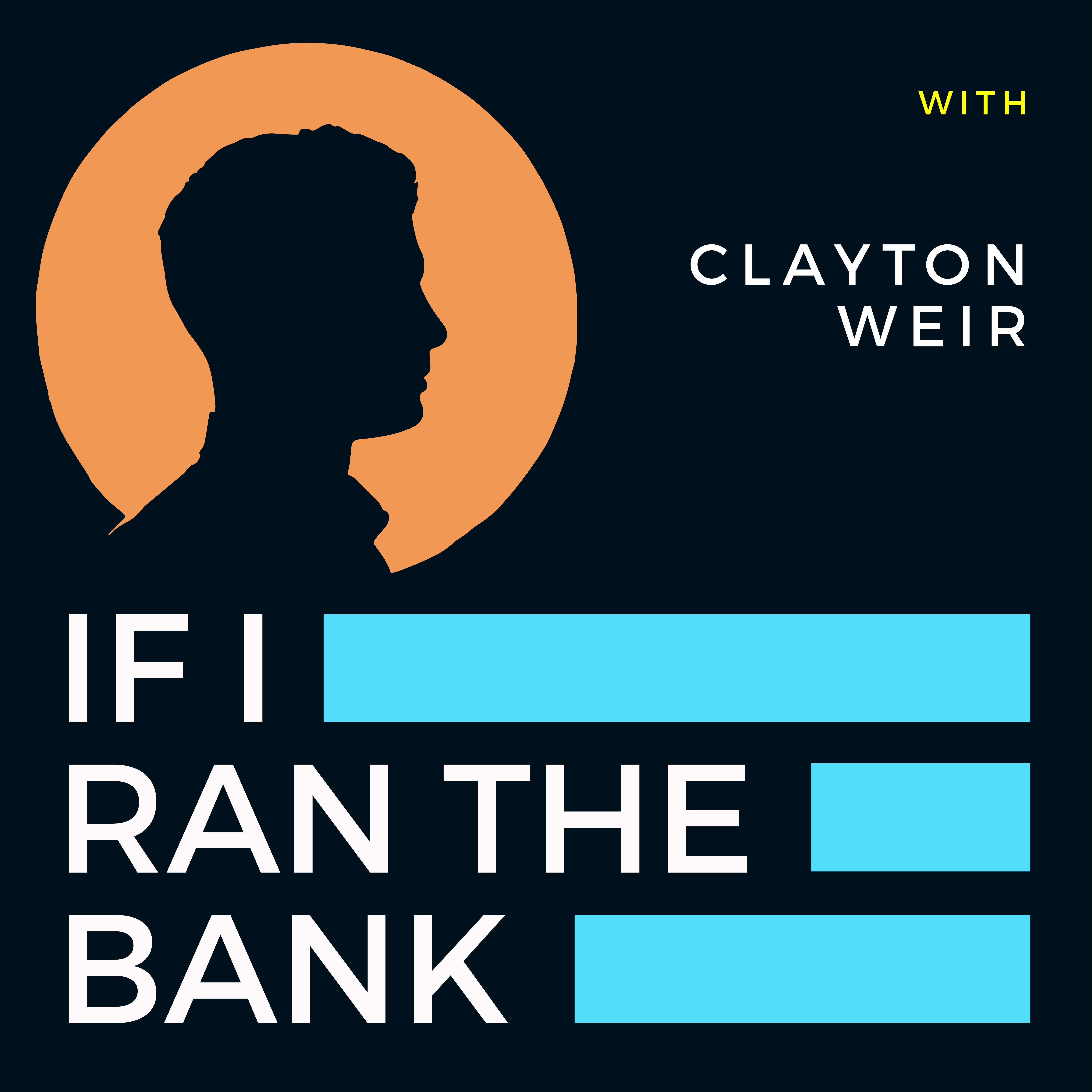How VCs Boost Bank Innovation with Melissa Widner
- 0.5
- 1
- 1.25
- 1.5
- 1.75
- 2
Voiceover: If I Ran The Bank is a podcast hosted by Clayton Weir, co- founder and head of product strategy at FISPAN, a fintech that is enabling banks to provide contextualized consumer life experiences to their business clients. Clayton's a thought leader in financial innovation and hits on the hottest topics in banking, finance, and the future of payments. And he wants to know, if you ran the bank, what's the one thing you'd go all in on. Please tune in to Spotify, Apple podcasts, Google play, or wherever you get your podcasts. And now here's your host, Clayton Weir.
Clayton Weir: Hey everyone. Welcome to another episode of If I Ran The Bank. Today, we're super lucky to have Melissa Widner as our guest. She's joining from the lovely, and almost certainly sunnier than here, Sydney, Australia. The reason I invited her was she just finished up a tour of duty working as a corporate venture capitalist for one of the largest financial institutions in Australia, National Australia Bank, or NAB. Since then, Melissa has jumped ship to become the CEO of a super interesting company called Lighter Capital that has an alternative financing product for SaaS- style businesses. I think between those two different stops, there's lots of interesting things to dive into around the future of how banks are innovating, where they're making their bets and investments on innovation, and also some of the white space opportunities that are left in how we capitalize different different types of companies. I'll stop there and throw it over to you, Melissa.
Melissa Widner: Well thanks, Clayton, for having me here. I have known FISPAN for several years now. I think I first came across that when I was the managing director of National Australia Bank's venture fund, and came across your CEO Lisa, and I'm a big fan of the company. So it's just great to see your continued growth. I consider myself first and foremost an entrepreneur. Before I went into venture capital, I ran a couple of companies. I was the founder and CEO of an enterprise software company called Seven Software that was out of the Valley, and it was acquired by a Seattle company called Concur Technologies. And shortly after that acquisition, I started a career in VC in the U.S., and then moved to Australia about 12 years ago. And when NAB was starting a venture fund I went in with my work partner, Todd Forrest, to get that going. So I did that for five years, which was great spending time in a large corporate and getting a fund going there. And one of our investments was a company called Lighter Capital, and it's an investment that I made while I was at the bank. And I went onto their board, and last year when we needed to replace the CEO, I was such a big fan of the company and had a real vision for where else it could go, that I threw my hat in the ring and decided to get back on the tools, as they say in Australia, and get back into the operating side.
Clayton Weir: Our CEO, my partner Lisa, has spent spent seven or eight years at some point in Australia. And the amount of bizarre aphorisms that she has has taken from that life experience are invaluable, I would say.
Melissa Widner: Yeah, it's a different language.
Clayton Weir: Yeah, no, they really know how to coin a phrase. So on that note, let's maybe start there and unpack that. So I think your journey as a bank venture capitalist probably really closely mapped to the overall fintech and disruption hype cycle, right? And so if you back to 2014, 15, 16 was sort of peak... When's banking and have its Blockbuster moment? We need to digitize and have innovation programs and DVCs and do all these things. I think the tenor of that's all changed, but do you maybe want to take us back to the time, and why would a bank want to be a venture capitalist?
Melissa Widner: Well, different banks have different reasons, and different corporates have different reasons for starting up venture firms. At NAB, it was started by our previous CEO, Andrew Thorburn, who really wanted to create a vehicle that would ultimately help bring a stronger culture of innovation to the bank. So banks are actually quite innovative, and in Australia I would say the banks are even more innovative than in the U.S. in some ways. It's probably easier to innovate in a smaller market and when there's fewer banks, but they don't obviously move quickly like startups do and it's a different mentality. So I think one of the reasons was to slowly shift the culture by exposure to some of these interesting companies. And when I think about what we did at NAB Ventures, we would invest really for three reasons. One, first and foremost, it would be partnership opportunities. And that was really the reason for investing in Lighter Capital. So Lighter Capital is a company that's been around for a decade. We're the pioneer and leader in this revenue- based finance for SaaS companies. So we're able to get in pretty early to help provide these companies with growth capital, when banks aren't going to lend to them because they're not profitable. They're not going to offer a personal guarantee or their house, so they don't have a lot of options for growth capital. And a lot of times our companies are even too early for venture, or they don't want venture. They might want venture eventually, but they're not ready for it at that time. So the reason NAB made an investment to Lighter, which is really illustrative of one of the reasons that NAB set up its venture firm, was in order to get closer to these companies that they really wanted to bank and have relationships with as they grew, but didn't necessarily have a differentiated product to offer at that early stage. Some of the big Australian tech success stories are Atlassian and Canva. So when NAB thinks about why we made the investment in Lighter and why NAB has a partnership with Lighter, it was... How do we engage with the companies like Atlassian and Canva at the early stage, and how do we provide them real value? And a lot of times, the value companies need the most at that early stage is capital. So that's one reason banks partner, one of the reasons that the venture firm was formed. And another reason is just to get insights into what's going on in the market. Where could we potentially be disrupted? A company that I did the investment in was a San Francisco company called inaudible that does cross- border payments. It facilitates cross- border payments, and this isn't something that NAB does and other banks do. For businesses, frankly, it's a clunky process. If you do a lot of it in your setup, it's pretty simple, but if you're just a small business that wants to pay an invoice to an overseas partner, it can be quite cumbersome and expensive in being set up, so we really simple. So that was an investment where the bank was looking for, "Let's look to invest in companies that are potentially going to have this." And so those are really the broad categories in terms of why NAB set up a venture fund.
Clayton Weir: Totally makes sense. And was it part of your mandate... Was it generally what was interesting, or were you trying to spread these ideas or opportunities around the different lines of business that the bank was in, or had they just curated the biggest pain points regardless of what it was? How do you set up your thesis that way and align it to the operating business?
Melissa Widner: Yeah, that's something that we spend a lot of time on in terms of... Because a bank, as you know, and what a bank does is so broad. So where do you start and where do you focus? And how deliberate are you versus reactionary? So we did look at specific areas. Another area that was one of importance, and now has three investments in this space right now, is in cybersecurity. And that's obviously very important for a bank. Probably as important for a bank or more important for a bank than almost any other institution. So that was an area where we used the venture fund to invest primarily in companies that we were already a customer, or were going to become a customer of, with the thesis that by having that closer relationship through an investment, we'll really be on the forefront of what's going on in this space that would help protect the bank and its customers. But in terms of prioritization, if you look at where a bank makes most of its money, or NAB makes most of its money, it's in lending and specifically in mortgages and small business lending, in NAB's case. So anything in that space was of interest to us. Anything that could bring a better experience for our customers. I keep saying our, even though I'm at Lighter now. For NAB's customers in that space was of interest, and NAB's portfolio is filled with companies that are in or around that alternative lending space.
Clayton Weir: Totally makes sense. And one of the other deals you guys did that was on my radar, always, because it was a Canadian company, was Wave. Which, I guess for people that don't know, is a really big small and micro business accounting platform.
Melissa Widner: Yeah. Great company.
Clayton Weir: Yeah. Really neat business. And if you could maybe walk me through that, but I think obviously probably part of that is, and I think part of... It's really interesting who ultimately bought that company. I think it would have been unobvious if you weren't thinking about it in advance. It's obvious after the fact, but that's probably even an example right of how important the system of record is to ultimately, probably some of this credit underwriting for the small businesses.
Melissa Widner: Yeah, absolutely. And we invested in Wave in 2017. And unfortunately, fortunately for all the shareholders including NAB, they were acquired by H& R Block a couple of years later, but acquired too early for us to really leverage that investment from a partnership standpoint. But Wave's a great company in terms of the leader for that micro accounting space. And why anything in that space is interesting to banks is when you think about what does, and what we do at Lighter, is we take data and then we make credit decisions based on that data. And a lot of that data resides in the accounting platform. So there really shouldn't be a step of a company having to provide that data to a lending institution. The lending institutions should be able to connect into that data and let companies know in real time what they qualify for. And that's really what Lighter has done. We can deploy capital very quickly. We connect to banking and accounting data, and based on our long history of living in this area, we can get capital out the door in a couple of weeks without an onerous application process for the customer.
Clayton Weir: That's maybe a great point of transition then, and I think it fits really well into a couple of the themes we've talked about this show. So obviously, data is the life source of so many industries now, and the ability to service the customer is dependent on access to data in so many verticals. So I think it's especially, obviously, true of providing credit and capital. But this is the interesting thing, and I think it's where banks have sort of gotten left behind a bit. It's just the nature of business has changed so much over the last 20 years, and you're much more likely to be in e- commerce. And realistically, the equivalent of if you were a small business making your nightly bag deposit out of the till into your bank, the point of entry is really something more like your Stripe account today, right? Or Shopify. That's where the, the flow of funds comes in. It doesn't even touch your bank. And so it's really interesting, as the cadence of those businesses have changed and everything, in a lot of ways the financing tools that incumbent banks make available to small businesses seem less and less fit for purpose over time. So I don't know if you'd maybe walk us through that from your perspective and maybe touch on where Lighter fits in that chain, but can you maybe describe that chasm or that gap, and some of the different sources of capital or some of the people trying to solve this problem are?
Melissa Widner: Yeah, and is the question specifically how we're getting our data? There's a couple of things in there, but I can talk about one thing that has changed, really even in the last few years, you know, Lighter's been around a little over a decade and really started the SaaS lending in about 2012. And if you go back even three or four years ago, we'd need to get the banking and accounting data to make credit decisions. And it would take a few phone calls and time with the customer before they trusted us to provide that information. And where things really changed now is in the very first... Oftentimes before there's any interaction at all, companies will connect us directly to these data sources and we can come back with a credit decision. And that's something that a few years ago companies were very reluctant to do, but that's become much more the norm. I think people understand that this being done in a secure and protected way, and also it probably has to do with Lighter's reputation. As Lighter builds its reputation and credibility, there's more trust there, but it's really quite a difference in terms of company's willingness to open up the data to lenders, and other third parties and partners.
Clayton Weir: That totally makes sense. I think that that's something that maybe gets lost, is that of all the things that sort of change in terms of societal attitudes and beliefs, is that now that as a small business owner or whomever you're so used to that idea of making this little OAuth connection between the 10 different SaaS applications that you use. So that idea of how that data gets exchanged, you're not even thinking about it. In some ways you're maybe even desensitized to whatever the risk may or may not be. You're way more ready to do that than, maybe, a legacy institution is to receive that data from you.
Melissa Widner: Yeah. And look, the CEO of a seed pre- Series A company is the most time poor person on the planet, probably. So anything you can do to expedite the process and their, and their job is not to fill out loan applications. Their job is to run their business and get more customers. So we are really focused on them. I've been at the helm at Lighter for a little over six months now, but one of our big focus areas is just making sure we're not spending a second of our customers' or our potential customers' time that we don't have to. And that means making the application process super simple. Not asking any questions that we get from data, never asking them the same question twice, getting back to them quickly and making sure we're not asking them questions that we don't really need to make our loan decisions. So we're at a point where we can deploy capital really quickly once we have all the data. And so we're just focused on how do we get that data quickly and make it as painless as possible for the customers to give us that data? And that's an area where banks are just going to be slower to catch up. And it just takes longer to get things like that done. And I know that from sitting in NAB, NAB's filled with very smart, strategic thinkers, but there's just a big bureaucracy to cut through to get changes made. Everybody knows, people seem to be agreed upon the direction that the bank needs to go. It just takes a lot longer to get those types of things done.
Clayton Weir: So of the two things that I think are... If I said, kind of as a dummy listening from the outside, I think are unique about your business and your approach. One is the speed of underwriting, like being able to get to a decision really quickly. And then two is probably just being able to understand a pattern or a cadence of businesses that a legacy financial institution just wouldn't. It wouldn't make sense how you run your business, wouldn't look right in their models. Those seem like the two most important things. Is that accurate? Is that kind of painting the whole picture?
Melissa Widner: Yeah. Our area of expertise is SaaS companies. So we have deployed over$ 200 million, have done over 800 loans and have looked at data from thousands of companies. So we were able to... We didn't really get a chance to talk about our product, but the product is such a great product. As an entrepreneur and as a venture capitalist, I have such appreciation for it, which is one of the reasons I was excited to join this company. But the revenue based loan is a loan where the company takes, say, a dollar from us and they're going to pay us back a fixed amount, but it's typically around$1. 30 or$1. 40. And we model that that payback will happen over three years, and they're paying us a fixed percentage of their revenue until they back that amount. So they know exactly what they're going to pay back, whether it's$1. 30 or$ 1. 40 or$1.50, depending on the risk profile. And we model for that to be paid back over three years. So what our credit decisioning tool does is it forecasts the company's revenue, because if we're saying," Okay, you're going to back 5% of your revenue. We're modeling this to be paid back over three years," now we're forecasting what we think the revenue's going to be. We never get that exactly right. We're always over under, but we've done a pretty good job. We're a lot better at forecasting customer's revenues than they are. And that's because entrepreneurs are generally, like me, they're optimists so generally forecast a little higher. So the reason it's such a great product is that if the company grows a lot faster than they anticipated or we anticipated, we get paid back faster. The company doesn't pay us back any more money. They're still paying us back$1. 30 or$1. 40, but they're paying us back faster and our IRR is higher. And that's how we make our profit. We make our profit on the spread between our cost of capital and our effective rate. And if the company grows slower, then our IRR is lower. So our interest is perfectly aligned with the customer's. We do better when they do better. It doesn't cost them any more money, and they're happy. If they're paying the money back in a shorter amount of time, that's fine because that means they have way more money than they had thought they were going to have because their revenues grew so quickly. And if they fall on tough times, then they don't have this onerous loan burden. So we went through COVID and, knock on wood, we didn't lose a single one of our portfolio companies. They've all survived so far, but we had a few in spaces that were very hard hit. So we had ones in event planning and ticketing, travel, and as you can imagine their revenues really contracted when COVID hit. So the amount that they pay us every month went down as well. So we have some companies that are paying us 90% less than they were a year ago on a monthly basis because their revenue is 90% less than they were a year ago. So we're never an onerous burden. There's never this loan payment that you have to make that's going to put pressure on the company. So it's just such a great, perfectly aligned product. I wish I had thought of it. I can't take credit, but...
Clayton Weir: It totally makes sense. And so if you play this out, as you kind of have a specialist product that's highly aligned to a certain business with certain cadence of cash flow and certain life cycle. And I think there's multiple of these, right? If you start to cast a broader swath and you think of ClearBank, or what Shopify does in this space, or what Square does is you have all these people that, A, have... I think I said two things. I think there's three things here. One is quick underwriting. Two is access to proprietary data. And three is some general deep understanding of the cadence of a specific type of business. And so that pattern is replicating with these people that really understand e- comm or physical retail or whatever it is, and have privileged data access. So it just seems that that model is going to propagate itself multiple times, but it's interesting because it's the exact opposite of how banks work, whereas this is inherently sort of verticalized to make that model work. There's a certain type of data access, certain type of knowledge, certain type of product design. Whereas small business bank lending was a very, very horizontal offering, realistically.
Melissa Widner: Absolutely. Absolutely. And that's the thing that, at NAB, they started a couple divisions of bankers to focus on emerging tech companies, and there's an e- commerce teams. So you have bankers that are specializing in specific verticals. NAB's also a big ag bank, the largest agricultural bank in Australia. But the products are differentiated, so the banker's knowledge is differentiated because they're working on this specific vertical, but the lending products haven't caught up there.
Clayton Weir: No, I think that makes sense. And it's easy to do that, the verticalized thing. And I had a little bit of earlier life expense myself. I worked at Farm Credit Canada, so it's the-
Melissa Widner: Oh, great. Yeah.
Clayton Weir: Yeah, when I was in university. And that was it. They had to go a level deeper, so specifically to Eglin and stuff. I get that. So on that note, and I guess the simple answer is," Well, change the product and change the technology," but if you were sitting on the bank side of things, how do you sort of modernize... What would your vision be for modernizing a portfolio of credit or financing products that you think are better fit for purpose of how the world's going to be, where the puck is going?
Melissa Widner: Yeah, so one of the things that should be low hanging fruit, and it was for us at Lighter, is just the front end customer experience. So I look at one of NAB's portfolio companies is a mortgage company, a company that provides mortgages called Athena, and it was actually founded by two ex- NAB people. And the bank should be the best at mortgages, right? They have the lowest cost of capital, they have the most data, nobody should be told to eat their lunch in that department. And really what Athena has done is they've just made the process so much simpler for customers. So that front end piece is something that always surprises me. It really does surprise me how banks don't know... That's not something they do well. They spend a lot of time on it. They spend a lot of time on customer journeys, but I think it's because they're looking at it as a piece of such a broader set of things that needs to happen before they can even implement that front end piece. They're just slow to catch up there. And that's something that... Customer experience is just key. And it's got to be fast, you've got to not be wasting time, and I think that's something that banks in general just don't pay enough attention to. So if I were running the bank, I would make that a priority. And I would say," The back end is really important as well, but the customers don't see the back end. So let's at least get that front end fixed and we can fix the back end at our leisure."
Clayton Weir: Yeah. I mean, you can Wizard of Oz the experience for the user inaudible.
Melissa Widner: Exactly, yeah. because the customer doesn't care as long as they're getting their cash quickly and it's not taking a lot of their time. I like that, Wizard of Oz, that's a good word.
Clayton Weir: That totally makes sense. On the small business side, do you think for the banks to verticalize small business credit products makes sense? Would it ever make sense for a bank to do that, to have something that was specific to SaaS companies or specific to marketplaces or e- commerce companies or things like that?
Melissa Widner: Yeah, it absolutely makes sense, but it would be hard to do. And I think that's why when we look at NAB that here in Australia, and we partner with Silicon Valley Bank in the U. S., why that's partnered with Lighter, because they really want to have relationships with these high growth, early stage tech companies, but they don't have the product. And if the bank is looking at verticalizing, this would probably be low on the list just because of the size. So they'd start with ag, like they do have a vertical focus in ag. They've got a vertical focus in health, and when you just think about overall size inaudible pretty far down. So I think partnership is a good strategy in terms of being able to offer something to specific verticals.
Clayton Weir: Just putting your investor hat back on for a second, and obviously you still probably see lots of quite unique deal flow through Lighter Capital funnel, can you maybe give us a space maybe tangential to this, a fintech category you're still really excited in and would be eager to invest in? And maybe something on the other side of the coin that you think is a little bit over- hyped when it comes to FinTech and startups?
Melissa Widner: You mean another vertical space beyond SaaS?
Clayton Weir: Sorry, I just mean something not related to lending, I guess.
Melissa Widner: In fintech. Okay.
Clayton Weir: Yeah.
Melissa Widner: Oh, gosh. There are so many areas at NAB. I think there's still a lot to be done in the real estate space. One of NAB's portfolio companies is a company called Amitree that has an email AI assistant specifically for real estate agents. That's just a fantastic product, so that was something that was very interesting because when you think of where banks make... A lot of their cash profits are from mortgages. So anything in and around the real estate space is really interesting, and there's a lot of opportunity for improvement and automation there. And within real estate, there's so many different verticals. There's property management. There's just, even, why in the U.S, Are you still paying 5 to 6% commission when you have perfect information now compared to 25 years ago, when you needed a real estate agent to show you what even was for sale? Why have commission rates... They've dropped a little, but they really haven't come down that much.
Clayton Weir: And actually, I guess that's another... Whenever you get de- quarantined and get back to Seattle, Zillow has obviously done some really interesting things in that space, with their iBuying. Seems like we're kind of in the earliest chapters of real estate maybe getting... It's obvious how it should work, it just seems like we're always 10 years away from it working the way it should.
Melissa Widner: Yeah. I remember talking with the founder of Redfin early on when I was a venture capitalist in Seattle, maybe it was the 2002 or 2003. And surprisingly, Redfin's done really well, but the whole thesis was that it was going to displace the broker and real estate commissions were going to come down significantly. And it's become more of a tool for brokers, and we haven't seen that change radically. So will we still be talking about this 10 years from now?
Clayton Weir: Almost certainly. And it's weird, and I don't know the numbers, but to some extent it seems to me that like the robo- advisor type products have done a better job of attracting capital to them that. I would have thought that that was like," Oh no, there needs to be a human involved. I don't want the robot to set my portfolio," but people feel open- minded on that, but still want a human to pay 4% to in the middle of the real estate transaction. It's very bizarre.
Melissa Widner: Yeah, absolutely. And trading platforms like Robinhood, which I know has gotten a lot of bad press lately, but one of NAB's investments is in a company called Stash. I don't know if you're familiar with Stash, but that's a great product you can get on and do fractional share investing. And they have a debit card that every time you spend at a public company with the debit card, you actually get shares in that company. So what it does is not only does it foster a greater alignment between the customer and the vendor, but it's actually getting people to become investors much earlier than they normally would, or getting even a whole different class of investors that might never become equity investors, to become educated on how to do so.
Clayton Weir: I did see them present at Finovate once. That was one of the few times in my life where I was like," That idea is just beyond obvious."
Melissa Widner: It's such a great company. Yeah. I chased that one for three years before we did the investment at NAB.
Clayton Weir: Yeah, no, it has a lot going for it, and a lot of interesting things just in terms of the way, as you said, it folds people in as equity investors earlier. It's actually really interesting that that hasn't ever been a thing, trying to convert the idea of a loyalty program into actually being a shareholder. I can't fathom how many interesting ramifications there are out of that, of the affinity that it actually creates connection to brands and stuff.
Melissa Widner: Yeah, absolutely. And another one of NAB's investments is into a company that called Slyp that does digital receipts. And that might sound super simple, but there's so much more that can be done when it comes to loyalty warranties around that space. So that's something where when you buy something, on your credit card statement or your debit card statement, instead of just seeing the name of the vendor and the amount, you'll actually see line item detail. And that's super useful. The biggest use for the bank is just that the bank spends, I think it's literally millions of dollars handling phone calls from people who think this wasn't a charge that they made because they can't remember. They see a charge from some vendor and they can't remember ever going there, but when you put the line item in there, they would remember. But then it gets into, in terms of being able to provide loyalty programs, provide data to consumers on their spending at a much more granular level. There's so much that can be done in that area, and I think Slyp now has investment from all the four large banks in Australia.
Clayton Weir: I thought that was a really neat idea as well. I think it just creates a circle of life conversation around the data that exchanges between the merchant and the customer and the bank, I guess, in this case. And I think that's going to be the next phase of buy- now- pay- later as well, because it's been a merchant- only experience mostly, and now it's going to be a bit more of a... There's some people trying to do it on the card side as well. And I think there's going to be a little bit of a push and pull of who owns the relationship, whether it's on the merchant side or the issuer side as well. So I think that's all going to kind of blend together. Awesome. Well, why don't we wrap on that note. I really appreciate the conversation. I think that all these are important themes. They involve how banks are choosing to invest and evolve themselves and innovate and do that, but also I think fundamentally the nature of how we finance businesses is changing and probably will continue to change quite a bit. And I just think that that's something that's really interesting. So I really appreciate you taking the time to share your thoughts on both sides.
Melissa Widner: Yeah, it was great to be here. Thanks so much for having me.
Clayton Weir: Awesome. Thanks again, and thanks everyone for listening as always. We appreciate it. If it's your first time listening, feel free to subscribe on Apple, Spotify, anywhere you get your podcasts and never hesitate to send us a note at info @ fispan. com if you have any comments, questions or concerns, or maybe you want to be a guest, but thanks for listening.
DESCRIPTION
Melissa Widner is the CEO of Lighter Capital and former Ventures Managing Director at National Australia Bank (NAB). With many years of experience in the financial industry as an entrepreneur, founder, CEO, and investor, Melissa Widner brings global insight to the most recent episode of the If I Ran the Bank podcast where they discuss how venture capital firms and revenue-based financial loans can boost innovation!
Today's Host

Clayton Weir
Today's Guests
